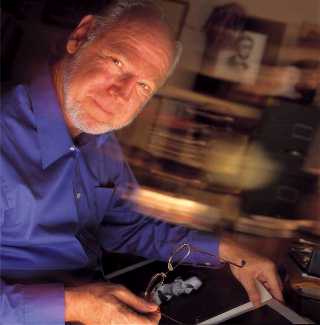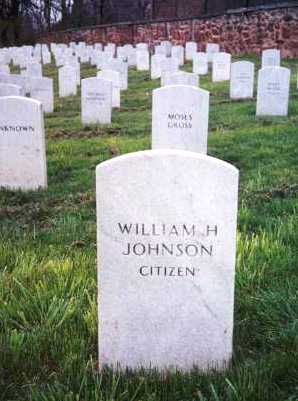Home | News | Books | Speeches | Places | Resources | Education | Timelines | Index | Search
Professor Ron Rietveld; Photo Courtesy of Philip ChanningLincoln Memories
Ronald Rietveld, professor of history at California State University-Fullerton, is known among historians as the person who found the only known photograph of Lincoln in death. You can read that fascinating story in " The Magnificent Find."In "Lincoln Memories" Dr. Rietveld (pronounced "REET-veld") recalls how he met the last surviving person to see Lincoln's body, talked with a man who knew Lincoln as a child, corresponded with author Carl Sandburg, and visited the grave of William Johnson, who was Lincoln's White House valet.
Meeting the Last Person to See Lincoln in Death
In the fall of 1962 I met Fleetwood Lindley, the last person alive who had seen Lincoln's remains. His experience was to be the final episode in the unbelievable story of Lincoln's body. I visited with Fleetwood at the Clayville Tavern, the old stage stop on the way to New Salem from Springfield, Illinois. Fleetwood died on February 1, 1963, and was the last of 23 people who could say, "I saw him." So I knew the last person who could say that.
Eleven years after Lincoln was laid to rest at Oak Ridge Cemetery in Springfield, a band of thieves broke into the Lincoln monument and almost made off with the martyred president's body. After that, a small group of Lincoln's friends hid the coffin between the tomb's walls, and for years visitors paid homage to an empty sarcophagus.
In 1900 the monument had to be torn down and rebuilt. When the present tomb was completed, the bodies of the Lincoln family were moved into the new tomb and preparations were made for the final interment of Lincoln's remains. Fleetwood's father was a friend of Lincoln and one of the self-appointed Guard of Honor who assumed responsibility for the safety of Lincoln's remains. Fleetwood was 13 years old in 1901 when Lincoln's body would be moved from outside where it was, to inside the tomb.
Fleetwood told me that his father called his school and his teacher suddenly dismissed him in the middle of class. His father had asked that he hurry to the tomb, but to tell no one about his errand. He did not know what he would see but his father had told him that when he viewed Lincoln's body 14 years before, it had been the color of an old saddle. His father met him and took him into the chamber where he saw several of the Guard of Honor plus the two plumbers who had opened the coffin in 1884. These two men sealed the coffin in 1884 and now they were going to re-open it.
He said paper was put over the windows so no one could see into the tomb. He watched as the plumber opened the green-colored lead coffin lining above Lincoln's head. A pungent, choking smell arose. All 23 people, including Fleetwood, saw a dark brown Lincoln face with the distinct rubbing of white chalk which had been applied by a Philadelphia undertaker during the long funeral trip in 1865.
Fleetwood told me that any school child would have recognized the face of Abraham Lincoln. The headrest had fallen so that the neck was thrown back, but the short black chin whiskers were perfect. The small black bow tie, the wart on his cheek, the coarse black hair were all unmistakable, although the eyebrows were no longer there. Lincoln was dressed in the black broadcloth suit which he had worn for his second inauguration. Over his hands were still stretched an elegant pair of kid gloves.
Without question, Fleetwood said, everyone who was present clearly identified the remains to be those of Abraham Lincoln. "His face was chalky white. His clothes were mildewed." Then the coffin was resealed by the plumbers. "I was allowed to hold one of the leather straps as we lowered the coffin for the concrete to be poured." As a security measure dictated by Robert Todd Lincoln, the president's son, the coffin was lowered into a metal cage and covered with two tons of cement, where it now rests 10 feet beneath the tomb floor.
Fleetwood said he remembered the experience clearly. He could still recall seeing the face and realized at the time that it was a lifetime experience. Then I shared with him that I had been about the same age when I found the photograph of the president's remains. When I was present at a conference in Springfield on Lincoln's Birthday some years ago, I was talking about Fleetwood with someone. A man came up behind me and said Fleetwood was his uncle. He didn't know that anyone remembered Fleetwood Lindley.
Talking with a Man who Knew Lincoln
I remember James F. Wheeler, 88, of Des Moines, Iowa. Shortly after the Des Moines Register published its front page article on my discovery of the last Lincoln photograph in 1952, I received a phone call. The voice on the other end told me that he had known Lincoln as a young boy when his father was Lincoln's gardener in Washington, DC. Would I like to come over for an afternoon visit to "talk Lincoln?" Of course I would!
He was a pleasant man and remembered vividly that "during Lincoln's administration my father was the White House gardener and I used to go with him quite often to the White House gardens -- two or three times a week." He observed, "Seems like people were more sociable than than they are now. I saw Mr. Lincoln many times. He told me, "He and my father were great friends" and that the President "used to play with me sometimes, for he was very fond of kids, and quite a joker."
Mr. Wheeler told me that there was a fig tree near the White House, and remembered that he used to help himself to them. "Mr. Lincoln would tease me about stealing his figs." He added, "My father would decorate the White House for all the official receptions, and he and my mother attended many of these functions."
His most poignant recollection of Lincoln concerned the martyred president's death. His father helped install the White House mourning decorations. He also remembered the search for John Wilkes Booth, Lincoln's assassin. "That was an exciting time in Washington," he said. "I remember the soldiers coming to our house one night as they did to most houses in Washington, looking for Booth." He recalled that it was about two o'clock in the morning, and he was "scared nearly to death."
Then he told me how the Lincoln coffin photograph in the paper had brought back memories. "My father took me to the Capitol for a last look at Lincoln. The president was lying in state in the Rotunda, "and my father lifted me up so as to see him better." He said, "Father was all broken up after Lincoln's death and decided then that he might as well leave Washington." And they moved to Iowa.
Corresponding with Carl Sandburg
As a boy I got interested in Lincoln about 1942. I had a heart murmur and wasn't allowed to play sports. At the time, it was thought that children who had heart murmurs might just fall over dead. So I had to do something, and I turned to the world of reading. Early on, American history attracted me and Washington and Lincoln became my heroes. Then I began to write people. I wrote to the last living Civil War veterans as a boy -- there were still seven alive in 1950 when I wrote them. Supposedly the last one died in 1959 at 117; there's a debate about that particular one.
I also wrote to Carl Sandburg, the poet who was known for his Lincoln biographies. When I was in fifth grade the Des Moines Public Library let me check out books in the adult section because I had devoured everything on Lincoln and the Civil War and George Washington in the children's section. So I checked out Carl Sandburg's set on Lincoln and read it. Then I decided to write to him. I got his address after a lady at the library helped me find it. I know I wrote him at least two letters.
After I was in Springfield a few years ago, Dr. Bob Johannsen, who was my professor and mentor for my doctoral dissertation at the University of Illinois, sent me a letter with two enclosures. I didn't think much about it, and laid them aside like I did with the Lincoln death photo, and read his letter. He wrote, "I found these in the Carl Sandburg Collection and thought you might be interested."
When I opened the first one I thought the handwriting was familiar and then I read it -- it was my letter to Carl Sandburg! Sandburg had saved both my letters and the envelopes with three-cent stamps on them. He also sent me an autographed photograph of himself, and one time when I was showing it in the classroom, somebody lifted the picture.
Visiting the William Johnson Gravesite
William H. Johnson was described as a free "colored man" who came with Lincoln from Illinois and became President Lincoln's part-time valet and messenger of the Treasury Department. He worked for Samuel Y. Atlee of the Treasury in the afternoon and tended to Lincoln's wardrobe, shaved him, and did other personal services for the president in the morning.
On November 18, 1863, Lincoln wrote a note explaining that Johnson would travel with him to Gettysburg for the dedication of the soldiers' cemetery. Mrs. Lincoln did not accompany the president because their son Tad was ill with smallpox. Once in Gettysburg, Lincoln must have mentioned Tad's condition to Edward Everett, the featured orator at the dedication, because he later wrote him, "Our sick boy, for whom you kindly enquired, we hope is past the worst." After delivery of his now famous speech, Lincoln also felt ill and on the return train trip to Washington "lay in a relaxed position with a wet towel across his head," placed there by Johnson.
Upon arrival at the White House, the president was put to bed and his doctor was called, who remarked, "Mr. Lincoln's case is not fully developed yet. Varioloid." The White House became a virtual smallpox hospital. Out of it came a touch of Lincoln's humor. "Now let the office-seekers come, for at last I have something I can give all of them." But he probably gave it to his valet, and Johnson died. Lincoln requested that he be buried in what is now called Arlington National Cemetery, and paid for his burial and tombstone.
Photograph by Ron RietveldOne day I told a friend who worked at the Reagan White House that I wanted to locate Johnson's grave. So we drove to the cemetery and the military guard motioned us to the left when we needed to drive to the right. My friend yelled, "I have a Lincoln scholar here who wants to locate the grave of Lincoln's black valet." Immediately he motioned us to drive to the far right side of the cemetery. There we found the simple grave. The stone reads "William H Johnson," and below that, "Citizen." Johnson died sometime before January 28, 1864, when Lincoln appointed Solomon James Johnson as his Treasury messenger replacement. Today, a black valet of President Lincoln rests as a citizen in Arlington National Cemetery.
Related Links
Assassination Links
Ronald Rietveld Video on the Assassination (Drake U.)
The Magnificent Find
Home | News | Education | Timelines | Places | Resources | Books | Speeches | Index | Search Copyright © 2016 Abraham Lincoln Online. All rights reserved.


